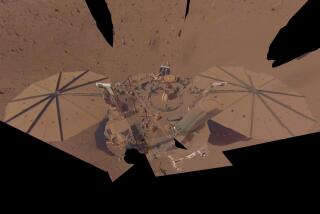An alien world dripping with water? Scientists see possibility of life
Scientists have found the shredded remains of a large, water-rich asteroid raining down on the embers of a dead star, 170 light-years from Earth.
It is the first time that scientists have found a mix of rock and water in a solar system that is not our own. The discovery also suggests that hundreds of millions of years ago, this distant solar system could have been conducive to life as we know it.
“What we know is that this system had the main ingredients to build planets like the Earth,” said Boris Gänsicke of the University of Warwick in England, who coauthored a paper about the discovery.
At the center of the system is GD61, a white dwarf star that is surrounded by a disk of dust and small rocks. The disk is the remains of a large asteroid, or possibly a minor planet, that orbited the star. After the star ran out of fuel and condensed into the small, dense white dwarf, its gravity became 100,000 times stronger than the gravity on Earth, and tore apart anything that got near it.
Now, pieces of the shredded asteroid are raining onto the white dwarf, and as they fall closer to the burned-out star, astronomers have been able to study the chemical composition of the debris.
What they have found is a chemical signature with lots of oxygen, which leads them to believe the parent body of the debris was composed of as much as 26% water. For comparison, Earth’s mass is only about 0.023% water.
Gänsicke said the original asteroid may have had a thick layer of water ice beneath a rocky crust, similar to the makeup of the dwarf planet Ceres in our solar system. It is possible that similar asteroids could have delivered water to other planets in the system.
It is unlikely, bordering on impossible, that an asteroid or a dwarf planet would be the only planetary body to form in a solar system, said Gänsicke, so it is likely that the system once had more planets and perhaps still does.
“With the current instruments we have, we can’t see any planet still orbiting the white dwarf, but we are quite certain there must be planets we can’t see yet,” he said. “We may be able to detect planets in the future.”
And whether those planets have water, and even possibly life, remains to be seen.
A study describing the discovery was published in the journal Science.
Want to read more about the search for life? Follow me on Twitter.
Also:
Do Jupiter and Saturn have diamond ‘rain’?
Found: A planet with no star, free-floating in space
Tupperware in space? Cassini finds plastic ingredient on a Saturn moon







